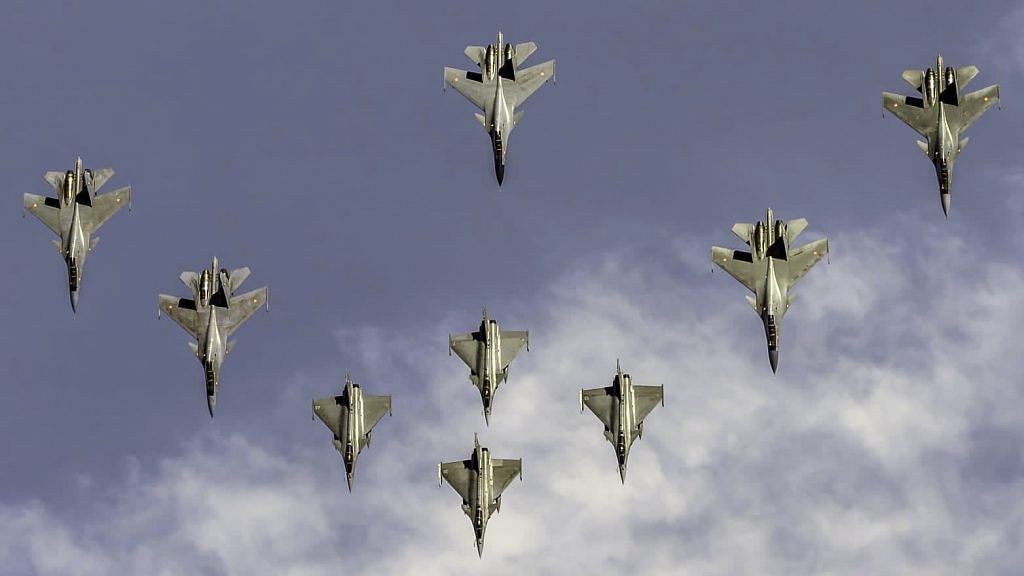New Delhi: Noting that India’s approach to air power as merely an arm to support joint operations significantly limits its strategic options and narrows its security response matrix, the Indian Air Force (IAF) has come out with a new doctrine that includes lessons from the Russia-Ukraine war and standoff with China.
The latest unclassified doctrine, released over the weekend, which takes over from the one that was set in 2012, emphasises on the need to shift from “threat-based and demanded” to “capability-demanded” force requirements.
This comes at a time when the IAF faces an existential threat to its fighter squadron strength which is dwindling and its plans to procure 114 more Multi Role Combat Aircraft (MRFA) under Make in India is yet to be sanctioned.
While the doctrine talks about the need for unified war fighting strategies, it also lays emphasis on retaining the unique character of air power, that has the capability to be used as support to the ground and maritime forces. The document also states that air power can be used for carrying out offensive strikes deep inside enemy territory to cripple logistics and key installations.
It says that while aerospace power may not win a war on its own, no war can be won without it. The new doctrine underlines that modern conflicts can be decisively influenced only by each component of military power operating in synergy with each other and optimally exploiting the unique attributes of its medium of operation (air, land and sea) to achieve national objectives.
This necessitates an intimate understanding of the core competencies, capabilities and limitations of each Service by the other two, it said.
It added that aerospace power can best be exploited jointly with other components of the military, but independently in tandem with diplomatic efforts and other elements of Comprehensive National Power, which includes everything from military to economic, social, and diplomatic heft.
The forward by IAF chief Air Chief Marshal V R Chaudhari notes that the multi-role capabilities of modern day platforms and weapon systems offers wide ranging opportunities.
“These platforms are capable of rapid role change and thereby provide multiple options to the aerospace power practitioner. It is important that such flexible assets are employed cohesively as per the emerging situation and not limited to constrained usage in a defined area or in a particular role,” he said.
His views come at a time where there is a larger debate within the defence and security establishment on whether theatre commands are the way forward – under which military assets would be divided – or a united and synchronised war strategy is important.
Also read: How France is ready to help India diversify from Russia — build fighters to submarines
From airpower to aerospace power
The IAF notes that given the new spectrum of warfare, airpower should be seen as aerospace power.
The Air Force called for a National Space Strategy as “concurrent vulnerabilities of India to hostile action” are increasing while also anticipating rise in use of space for economic and developmental purposes.
Noting that in the 1965 war, Peshawar airbase was considered safe as it was a depth airfield, it was still attacked by IAF Canberras launched from Agra.
“IAF’s capability has been enhanced to have a greater reach. While aircraft such as SU-30 and Rafale can project firepower onto Malacca and Sunda straits, the C-17s and C-130s can reach most parts of the globe. This capability of airpower, if exploited judiciously, can shape the outcome of the conflict,” it said, while emphasising on the uniqueness of air power.
From peace to war and no war-no peace situation
The new doctrine lays out the capabilities of the air force in times of peace, in war and in no war-no peace situations – what India is facing currently, vis-à-vis China.
Air Marshal Diptendu Choudhury (Retd), one of the key architects of the doctrine, told ThePrint that one of the reason for the failure of Russian Air Force in the war against Ukraine was because it saw air power as a support arm to the ground forces while ignoring its standalone capabilities.
He said the only time in India’s history when the IAF was fully used for offensive operations was during the 1971 War and the new doctrine aims to bring to the public and policy makers the possibilities that exist with air power.
It said that the ever evolving national, global and regional challenges have varying impacts on India’s security.
“Geopolitical re-balancing, increased assertiveness by emerging powers, regional instabilities, and the expansion of radicalism are but some of the present day manifestations. The perennial friction on the Northern and Western borders; state sponsored terrorism; left wing extremism; all underscore the magnitude of external as well as internal threats,” the document stated.
“A broad regional scan indicates growing security challenges which impact our political, economic and security interests in the Indian Ocean Region (IOR) spanning from West Asia to Southeast Asia and the larger Indo-Pacific construct,” it said.
IAF said that adversaries have adopted grey zone tactics by employing cyber, information and economic means as instruments of statecraft.
These challenges constitute a widened spectrum of conflict, from relative peace marked by sub conventional attacks, escalating to low intensity conflicts and finally total war, it said, adding that the nation is faced with challenges that require adaptive strategies.
“We need to be proficient in conduct of warfare in Land, Air, Maritime, Space, Cyber, EW (Electronic Warfare) and IW (Information Warfare) domains simultaneously at the Strategic, Operational and Tactical levels.
“India’s military therefore must build multi-domain capabilities and capacities that deter potential aggressors from hindering India’s pursuit of its legitimate aspirations and goals,” it said.
Also read: Fits between Tejas & heavier fighters — Why Lockheed wants India to buy F-21
